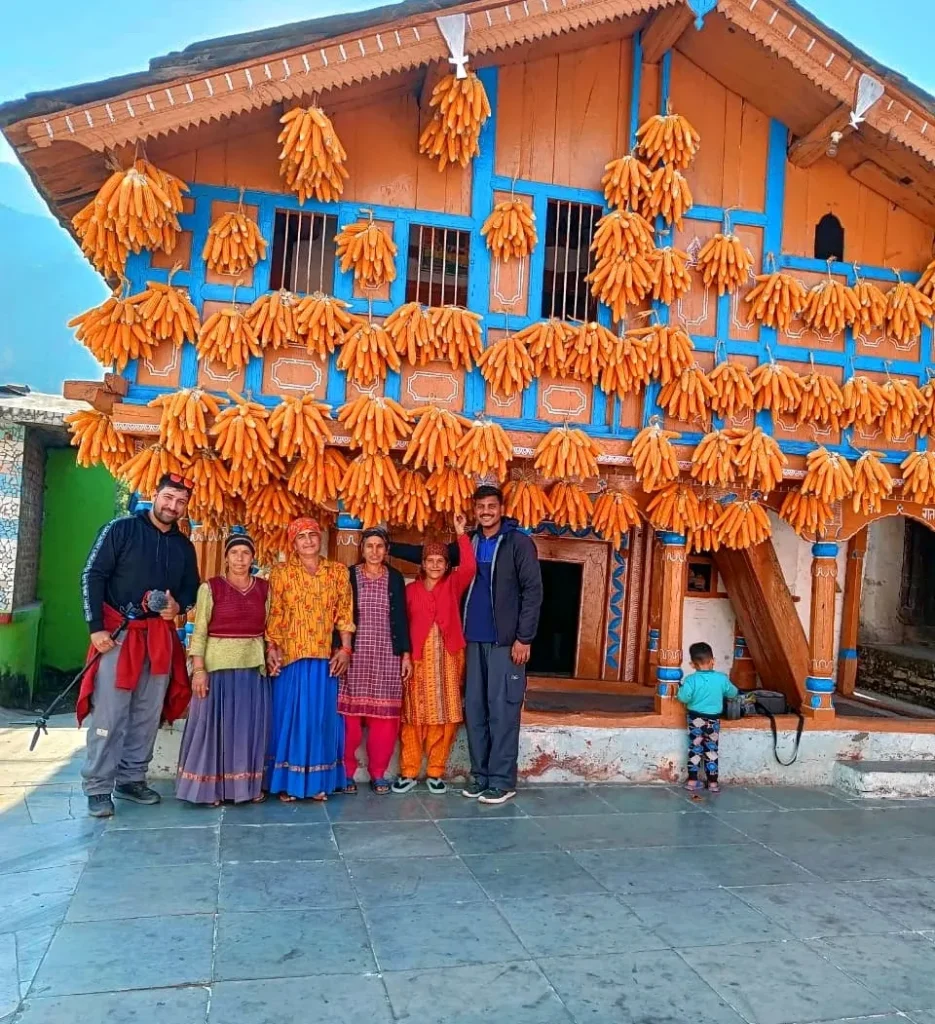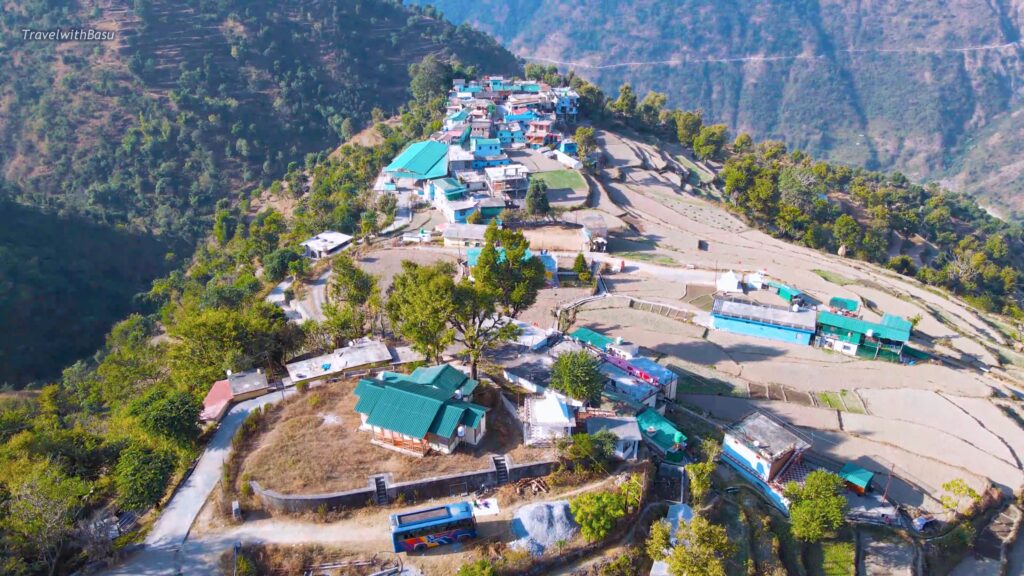Corn Village of India : Sainji

Crucial Information
Situated in Uttarakhand, India’s Jaunsar block in the Tehri Garhwal district.
About 30 km from Dehradun and 5 km from Mussoorie.
Renowned for its unusual custom of using corn cobs to decorate homes.
primarily home to the Jaunsari people, who are well-known for their customs and rich cultural legacy.
Provides a peek of sustainable life through corn-based crafts and organic farming.
Home of the Canadian woman-run Corn Village Cafe & Bakery, which serves baked products and regional specialties.
A well-liked vacation spot for travelers looking for a tranquil getaway and real cultural immersion.


Sainji Village: India’s Golden Treasure Wrapped in Corn Cobes
Nestled amidst the emerald embrace of the Garhwal Himalayas, in Uttarakhand’s Jaunpur block, lies the charming village of Sainji. More than just a picturesque haven, it’s fondly known as the “Corn Village of India,” its soul interwoven with the golden stalks that crown its houses and define its culture.
A Tapestry of Corn and Tradition:
Step into Sainji, and you’re greeted by a visual symphony. Every house, adorned with corn cobs strung into vibrant festoons, reflects the sun’s warmth in a thousand golden hues. This isn’t merely decoration; it’s a celebration of their staple crop and a symbol of prosperity. Corn, lovingly called “Makai” in the local Garhwali dialect, forms the bedrock of their lives, nourishing them physically and culturally.
Unique Practices, Enduring Values:
Life in Sainji unfolds at a gentle pace, guided by age-old traditions. Witness the rhythmic clack of the “ghana,” a water-powered mill grinding corn into flour for their daily meals. Immerse yourself in the melodious folk songs and dances that narrate their heritage. Savor their local delicacies, like the “Sirkiya,” a hearty soup made with corn and local vegetables, a testament to their resourcefulness and love for fresh, homemade fare.
Unveiling the Festive Spirit of Sainji: Beyond Corn and Cobwebs
Sainji, the “Corn Village of India,” isn’t just known for its golden fields and sustainable practices. It’s also a vibrant tapestry of festivals, each woven with unique traditions and local flavor. While corn undoubtedly takes center stage, these celebrations offer a glimpse into the heart and soul of this Garhwali community.
Budhi Diwali: A Beacon of Light and Renewal
Unlike the widely celebrated Diwali, Budhi Diwali, held in November, is a regional gem exclusive to Sainji and the surrounding villages. This “grand Diwali” signifies the triumph of good over evil and the welcoming of a bountiful harvest season. The festivities begin with the cleaning and whitewashing of houses, symbolizing purity and new beginnings. Villagers gather to light bonfires, their flames casting dancing shadows on the corn-adorned houses. Traditional folk songs fill the air, accompanied by the rhythmic beats of the “dhol” (drum) and “thali” (cymbals). Children giggle as they burst small firecrackers, adding to the joyous atmosphere. The highlight of the evening is the “Chhipkali” dance, where women dressed in vibrant attire perform around the bonfire, their movements mimicking the playful flickers of the flames. As the night deepens, families gather for a communal feast featuring delicacies like “Sirkiya” (corn soup) and “Bhang ki Chutney” (cannabis chutney), sharing stories and laughter under the starlit sky. Budhi Diwali is a powerful reminder of the community’s spirit, resilience, and deep connection to their cultural roots.
Makar Sankranti: Embracing the Sun’s Warmth
Marking the beginning of spring and the harvest of winter crops, Makar Sankranti is celebrated with fervor in Sainji. The air hums with the festive spirit as houses are adorned with colorful rangolis made from rice flour and flowers. Villagers gather for a special puja to the Sun God, offering prayers for a bountiful harvest and good health. The day is filled with traditional games like “tug-of-war” and “kite flying,” with vibrant kites soaring high against the clear blue sky. Women prepare a special sweet dish called “Khichdi,” made with rice, lentils, and jaggery, symbolizing abundance and prosperity. The evening culminates in a bonfire, where families and friends gather to sing, dance, and share stories under the starlit sky. Makar Sankranti is a celebration of light, warmth, and the hope for a prosperous new year.
Ganga Dussehra: A Reverence for the Life-Giving River
Held in May-June, Ganga Dussehra is a beautiful tribute to the sacred Ganges River, the lifeline of the region. Villagers gather on the banks of the river, adorned in traditional attire, to offer prayers and seek blessings for good health and prosperity. The highlight of the festival is the “Ganga Maiyya ki Aarti,” a mesmerizing ceremony where lamps are floated on the river, creating a mesmerizing spectacle of light and devotion. The festival also features cultural performances, folk dances, and traditional music, showcasing the rich cultural heritage of the region. Ganga Dussehra is a reminder of the deep connection between the community and nature, emphasizing the importance of respecting and preserving the environment.
Beyond the Festivals: A Glimpse into Daily Life
Festivals in Sainji are not just one-day events; they are woven into the fabric of daily life. Throughout the year, villagers gather for smaller celebrations like “Lohri” (harvest festival) and “Nanda Ashtami” (celebrating Lord Krishna’s birth), each with its unique customs and traditions. These gatherings strengthen community bonds, preserve cultural heritage, and provide opportunities for joy and shared experiences.
Visiting Sainji during any of these festivals is an immersive experience, offering a window into the vibrant culture and traditions of this unique community. It’s a chance to witness the deep connection between the villagers and their land, their reverence for nature, and their joy in celebrating life’s simple pleasures. So, come, step into the heart of Sainji, and discover the magic that unfolds beyond the cornfields and cobwebs – a tapestry woven with faith, tradition, and the warmth of a welcoming community.




My Experience
My journey began with a winding road, each turn revealing breathtaking vistas of snow-capped peaks and lush valleys. The anticipation grew as I finally approached the village, greeted by the sight of houses adorned with golden corn cobs, shimmering like festive jewels under the sun.
The warmth of the villagers’ welcome instantly enveloped me. Genuine smiles and curious eyes met mine, their simple attire and infectious laughter creating an atmosphere of pure joy. As dusk approached, the magic truly unfolded. Houses twinkled with diyas, casting a warm glow on the cobbled streets. The aroma of spices and roasting corn filled the air, whetting my appetite for the feast to come.
The highlight of the evening was undoubtedly the Budhi Diwali celebrations. The rhythmic beats of the dhol echoed through the village, drawing everyone into the festive spirit. Women, adorned in vibrant colors, performed the graceful Nati dance, their movements mirroring the swaying flames of the bonfire. Children’s laughter mingled with the crackle of fireworks, painting the night sky with bursts of light and color.
But the true magic wasn’t just in the spectacle; it was in the shared experience. Sharing stories with the villagers under the starlit sky, learning about their traditions, and witnessing their genuine joy in celebrating their harvest – these were the moments that etched themselves onto my memory.
As I bid farewell to Sainji, I carried with me not just souvenirs and photographs, but a warmth that lingered long after I left. The experience wasn’t just about witnessing a beautiful place; it was about connecting with a community, its spirit, and its love for life’s simple pleasures. Sainji wasn’t just a village; it was a tapestry woven with golden threads of corn, tradition, and the most precious thread of all – human connection.


